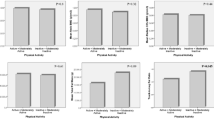Abstract:
Although relatively little is known about osteoporotic risk factors in women from the Indian subcontinent, osteoporotic fractures usually occur 10–20 years earlier in Indian men and women compared with their western Caucasian counterparts. The primary purpose of this cross-sectional study was to determine the relative contributions of ethnicity, reproductive history, body size (height, weight) and composition, bone turnover, serum 25(OH)vitamin D3 [25(OH)D3], dietary intake (of calcium, fiber and alcohol) and energy expenditure to femoral bone mineral density (BMD) in Indian and Pakistani (Indian/Pakistani; n= 47) versus American (n= 47) Caucasians. We also contrasted femoral BMD and hip axis length in these two distinct groups of premenopausal females living in the USA. The Indian/Pakistani (0.875 ± 0.096) women had lower (p= 0.0014) femoral BMD (g/cm2) than their American (0.937 ± 0.088) counterparts, placing them at greater osteoporotic risk. However, the shorter (p= 0.0002) hip axis length (cm) of the Indian/Pakistani (10.54 ± 0.57) versus American (11.11 ± 0.78) Caucasians might attenuate hip fracture risk in the former group. Significant contributors to proximal femur BMD were maximum non-pregnant lifetime weight, age at menarche, ratio of ∑central-to-peripheral skinfold thicknesses, calcium intake from milk and usual alcohol intake. Although serum 25(OH)D3 and urinary N-telopeptide concentrations did not contribute to femoral BMD in the regression models, the lower (p<0.0001) serum 25(OH)D3 (33.1 ± 16.5 vs 64.0 ± 22.0 nmol/l) and higher (p= 0.0004) urinary N-telopeptide (45.9 ± 43.3 vs 18.9 ± 18.7 nmol BCE/mmol) values in Indian/Pakistani versus American Caucasians, respectively, coupled with their lower BMD, places the Indian/Pakistani women at greater osteoporotic risk. These results suggest that a clinical trial to increase BMD and reduce osteoporotic risk is warranted in this ethnic group of premenopausal women.
Similar content being viewed by others
Author information
Authors and Affiliations
Additional information
Received: 29 April 1998 / Accepted: 12 August 1998
Rights and permissions
About this article
Cite this article
Alekel, D., Mortillaro, E., Hussain, E. et al. Lifestyle and Biologic Contributors to Proximal Femur Bone Mineral Density and Hip Axis Length in Two Distinct Ethnic Groups of Premenopausal Women . Osteoporos Int 9, 327–338 (1999). https://doi.org/10.1007/s001980050155
Issue Date:
DOI: https://doi.org/10.1007/s001980050155




